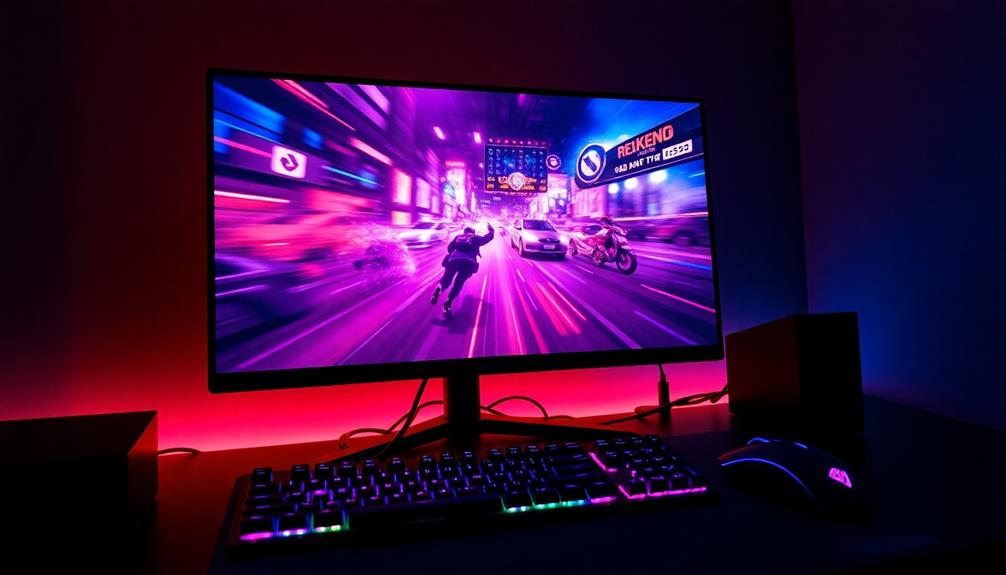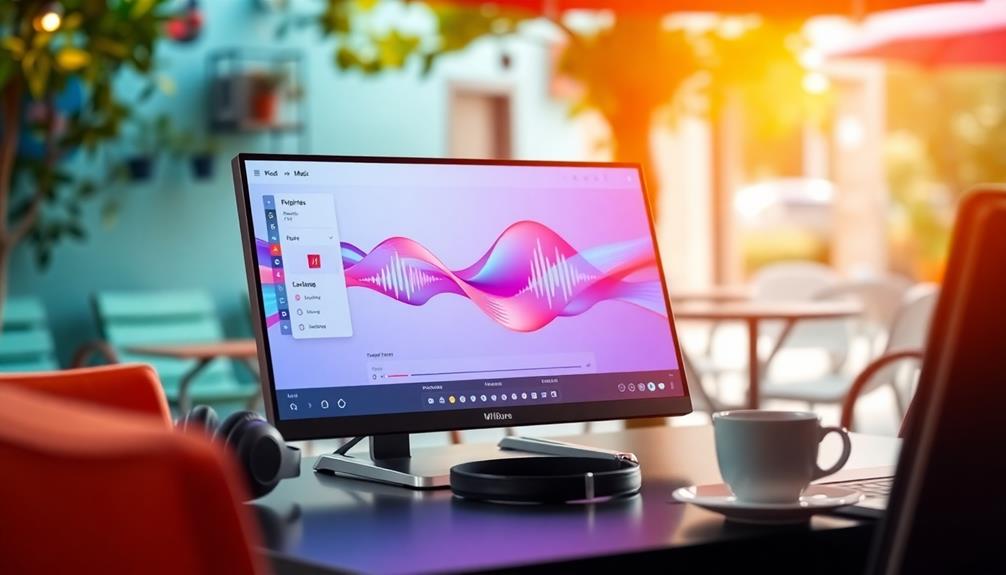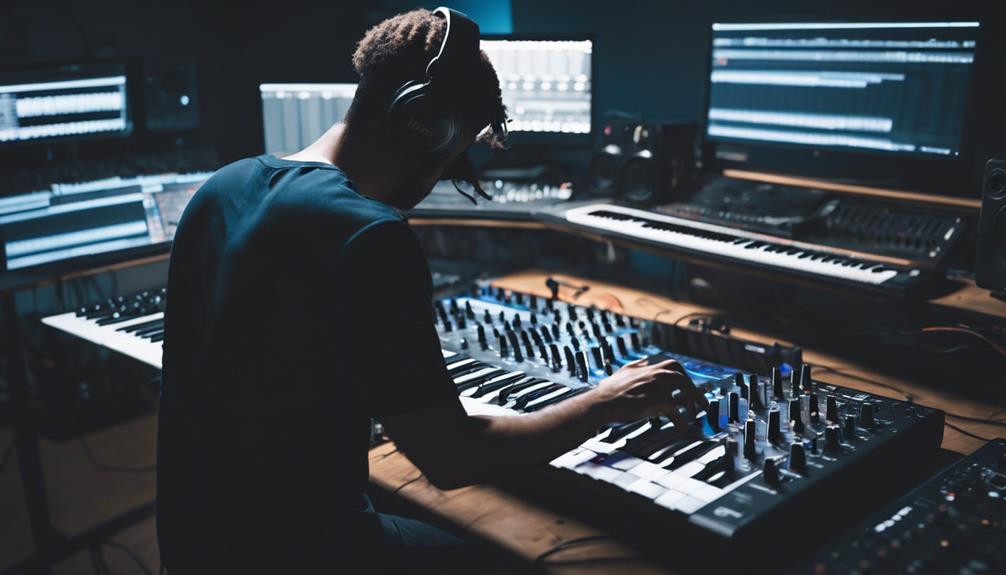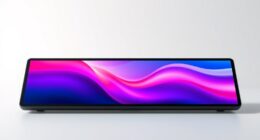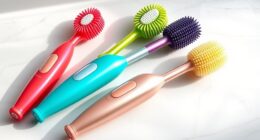In 2025, I’ve found some incredible MIDI controllers that can really elevate your live performances. The AKAI Professional APC Mini MK2 and Novation Launchpad Mini [MK3] are perfect for portability and ease of use. For more control, I love the Novation Launch Control XL and the PreSonus ATOM Midi Pad Controller for their seamless DAW integration. If you’re just starting, the Arturia MiniLab 3 is super intuitive. Each option brings unique features, pad sensitivity, and durability into the mix. Stick around, and I’ll uncover all the details you need to make the best choice for your music game. For those looking to pair their MIDI controllers with professional-grade gear, don’t overlook the importance of high-quality audio interfaces. Some of the best highend audio interfaces on the market can drastically improve your sound clarity and recording capabilities, making them an essential companion for serious musicians. Together, the right MIDI controller and audio interface can truly transform both your studio workflow and live performance setup.
Key Takeaways
- Look for MIDI controllers with robust build quality to ensure durability during frequent travel and live performances.
- Choose compact and lightweight designs for easy transport, such as the Novation Launchpad Mini [MK3] and AKAI Professional MPK Mini Play MK3.
- Prioritize velocity-sensitive and pressure-sensitive pads for enhanced expression and dynamic playability in live settings.
- Ensure compatibility with your preferred DAWs for seamless integration, particularly with options like Ableton Live and Studio One.
- Consider controllers that come with valuable software bundles to enhance your music production capabilities and overall value.
AKAI Professional APC Mini MK2 USB MIDI Pad Controller

If you’re an Ableton Live user looking to elevate your live performances, the AKAI Professional APC Mini MK2 USB MIDI Pad Controller is an excellent choice. This compact controller features 64 RGB pads arranged in an 8×8 matrix, making it easy to launch clips and monitor your performance visually. It comes with nine assignable faders for hands-on control of volume and effects, enhancing your mixing experience. Plus, it’s powered via USB, so you won’t need extra batteries or adapters. The APC Mini MK2 integrates seamlessly with Ableton, allowing for custom mappings if you’re using other DJ software. Overall, I find it portable, user-friendly, and a fantastic value for both studio work and live gigs.
Best For: DJs and music producers looking for a portable and user-friendly MIDI controller specifically designed for enhancing their Ableton Live performances.
Pros:
- Easy integration with Ableton Live, especially versions 11.2.7 and later.
- Portable design makes it suitable for both studio use and live performances.
- Hands-on control with 64 RGB pads and 9 assignable faders for enhanced mixing capabilities.
Cons:
- Setup challenges with MIDI command configuration can lead to frustration for some users.
- Limited compatibility with non-Ableton software may require additional setup for other DAWs.
- Sensitivity concerns regarding pad responsiveness and lack of comprehensive documentation on MIDI commands.
PreSonus ATOM Midi Pad Controller

The PreSonus ATOM Midi Pad Controller stands out as an ideal choice for musicians and producers seeking a versatile tool for live performance and studio work. With its 16 velocity- and pressure-sensitive RGB LED pads, I find it incredibly responsive for finger drumming and triggering samples. The integration with Studio One Artist is seamless, allowing me to access extensive controls easily. Plus, it comes bundled with over $1000 in software, which is a great value. While I’ve noticed some limitations when using it with other DAWs, its solid build and intuitive design make it easy to learn. Overall, the ATOM enhances my creative process and is a worthy investment for anyone serious about music production.
Best For: Musicians and producers looking for a responsive and versatile MIDI pad controller for both live performance and studio production.
Pros:
- Seamless integration with Studio One Artist enhances workflow and control.
- Responsive pads provide excellent tactile feedback for finger drumming and sample triggering.
- Bundled software worth over $1000 offers great value for music production.
Cons:
- Functionality may be limited in other DAWs, reducing its versatility outside of Studio One.
- Some users may find a learning curve initially, despite the intuitive design.
- Advanced mapping options are lacking when used in non-Studio One environments.
Novation Launch Control XL USB MIDI Controller for Ableton Live

For anyone looking to enhance their live performances, the Novation Launch Control XL USB MIDI Controller stands out with its seamless integration with Ableton Live. It features 24 pots that align perfectly with the Ableton mixer, along with eight faders and 16 multicolored pads for track control. I love how customizable it is, allowing me to set up user profiles and map buttons to my needs. The build quality feels solid, and the non-slip rubber base keeps it stable during gigs. Plus, the plug-and-play setup makes it incredibly user-friendly. I’ve found the fader response exceptional, making it ideal for both live settings and music production. If you’re serious about performance, the Launch Control XL is definitely worth considering.
Best For: Musicians and producers looking for a versatile and customizable USB MIDI controller to enhance their live performances and studio workflow.
Pros:
- Excellent fader response and overall responsiveness, making it ideal for live settings.
- Customizable user profiles allow for personalized control mappings to suit individual needs.
- Sturdy build quality with a non-slip base ensures stability during performances.
Cons:
- Some users report difficulty editing LED settings for pads compared to other controllers.
- Price point is about $50 higher than competitors like Akai, which may deter budget-conscious buyers.
- Lacks additional features, such as an integrated keyboard, which some users desire.
Novation Launchpad Mini [MK3] Portable MIDI Controller

Packed with 64 vibrant RGB pads, the Novation Launchpad Mini [MK3] is perfect for electronic musicians looking to enhance their live performances. Its lightweight, portable design makes it easy to take anywhere, weighing in at just 14.1 ounces and measuring 7.1 inches square. I love how it integrates seamlessly with Ableton Live, allowing quick launching of clips and scenes. The customizable modes let me tailor my setup for different sessions, ensuring I’m always ready to jam. Plus, the responsive pads provide great playability, even in low-light conditions. With support for various DAWs and a robust build, this controller is a fantastic choice for anyone wanting to elevate their music game on the go.
Best For: Electronic musicians and producers seeking a compact and versatile MIDI controller for live performances and studio work.
Pros:
- Seamless integration with Ableton Live for quick clip and scene launching.
- Lightweight and portable design, making it ideal for travel and compact setups.
- Customizable modes allow for tailored functionality and enhanced playability.
Cons:
- Limited feedback for non-Ableton DAWs during playback.
- Rubberized bottom may not provide as much traction on certain surfaces.
- Minimal controls compared to larger MIDI controllers, which may limit some users’ preferences.
Arturia MiniLab 3 Compact MIDI Keyboard and Pad Controller Bundle

Looking for a compact and versatile MIDI controller that won’t break the bank? The Arturia MiniLab 3 is a fantastic choice. With 25 velocity-sensitive keys, 8 backlit performance pads, and 8 rotary encoders, it offers plenty of functionality for both beginners and seasoned musicians. I love the built-in arpeggiator and chord modes, which really enhance creativity during live performances. This bundle includes essential software like Analog Lab Intro and Ableton Live Lite, giving you everything you need to start producing right away. Plus, its lightweight design makes it super portable. Although it has only 25 keys, the quality of the build and controls is impressive. Overall, the MiniLab 3 is a solid investment for anyone looking to elevate their music game.
Best For: The Arturia MiniLab 3 is best for beginners in music production who are looking for a compact and versatile MIDI controller with a solid feature set.
Pros:
- Excellent key feel and responsive pads make it enjoyable to play.
- Comprehensive software bundle included, enhancing overall value.
- Lightweight and portable design, perfect for musicians on the go.
Cons:
- Limited to 25 keys, which may be restrictive for some users.
- Pad responsiveness can vary, affecting performance consistency.
- Minimal labeling on the device may require some familiarization.
Blackstar Live Logic 6 Button Midi Foot Controller

The Blackstar Live Logic 6 Button MIDI Foot Controller stands out as an excellent choice for musicians who thrive in live performance settings. Its compact design features six buttons and MIDI over USB functionality, making it perfect for controlling DAWs, plugins, and live sampling software. I appreciate the two expression pedal inputs, which offer continuous MIDI control. Setting it up is generally straightforward, especially with its pre-configuration for Ableton Live. However, I’ve noticed some users struggle with switching modes and experience occasional disconnections. Despite these minor challenges, the solid construction and compatibility with devices like Guitar Rig and Fractal FM3 make it a reliable option. Overall, it’s a great tool for enhancing live music creation.
Best For: Musicians who perform live and need a compact, reliable MIDI controller for seamless integration with DAWs and effects.
Pros:
- Compact design and solid construction for portability and durability.
- Easy setup with pre-configuration for Ableton Live, enhancing workflow.
- Two expression pedal inputs allow for continuous MIDI control, expanding creative possibilities.
Cons:
- Some users experience disconnection issues, which can disrupt performance.
- Difficulty in switching modes may hinder quick adjustments during live shows.
- Limited battery life and manual power switch may require attention during extended use.
AKAI Professional LPD8 USB MIDI Controller

For musicians seeking a compact and responsive MIDI controller, the AKAI Professional LPD8 MK2 stands out with its 8 RGB-backlit pads. Weighing just 13.8 ounces and measuring 3.11 x 12.13 x 1.26 inches, it’s incredibly portable, making it perfect for live performances. The velocity-sensitive pads are not only responsive but also ideal for triggering samples and loops across various genres. With 8 assignable Q-Link knobs, I can easily map controls to my DAW’s parameters. The plug-and-play functionality means I can set it up without any hassle—no extra software needed! While it has some limitations, like only storing 4 presets, its robust build and playability make it a solid choice for any performing musician.
Best For: Musicians looking for a portable and efficient MIDI controller that offers responsive pads and intuitive controls for live performances.
Pros:
- Compact and lightweight design makes it easy to transport for gigs and studio sessions.
- Velocity-sensitive RGB pads provide dynamic playability suitable for various musical genres.
- Plug-and-play functionality allows for quick setup without the need for additional software or drivers.
Cons:
- Limited to 4 programmable presets, which may restrict customization for some users.
- Some users report compatibility issues with newer operating system versions, necessitating updated drivers.
- Lack of advanced features compared to higher-end MIDI controllers may not satisfy professional users.
Akai Professional MPK Mini Plus USB MIDI Keyboard Controller

Compact and versatile, the Akai Professional MPK Mini Plus USB MIDI Keyboard Controller stands out as an excellent choice for both aspiring musicians and seasoned producers seeking portability. With 37 mini keys and 8 RGB MPC pads, it’s perfect for dynamic beat-making and melodic performance. I love the built-in 64-step sequencer, allowing me to compose without a computer, which is fantastic for live settings. The advanced connectivity options, including CV/Gate and MIDI I/O, let me integrate various sound sources seamlessly. The transport controls and 8 assignable rotary knobs offer intuitive DAW navigation. While the smaller keys may take some getting used to, the overall functionality and portability make the MPK Mini Plus a valuable addition to my music production toolkit.
Best For: The Akai Professional MPK Mini Plus is best for aspiring musicians and seasoned producers looking for a compact and versatile MIDI controller for music production.
Pros:
- Responsive 8 RGB MPC pads enhance dynamic beat-making capabilities.
- Built-in 64-step sequencer allows for composing without a computer, ideal for live settings.
- Advanced connectivity options (CV/Gate, MIDI I/O, USB) enable seamless integration with various sound sources.
Cons:
- Smaller keys may affect playability for users accustomed to traditional-sized keys.
- Lack of faders could be a downside for those seeking more extensive control options.
- Limited documentation may pose challenges for beginners in fully utilizing the device.
Btuty BT MIDI Foot Controller Wireless

Looking for a reliable and portable MIDI controller for live performances? The Btuty BT MIDI Foot Controller Wireless might be just what you need. With its compact design and rechargeable 300mAh battery, it charges quickly in 2.5 hours and lasts up to 12 hours. I love that it supports multiple platforms like Windows, iOS, and Android, making it versatile for my setup. The intuitive display provides clear feedback, and the CubeSuite app helps streamline my music creation process. However, it does have some limitations, like latency issues and a max of four buttons without banking. Despite these quirks, it’s sturdy and generally well-received, making it a solid choice for musicians on the go. For those who prioritize convenience and adaptability, this controller pairs well with some of the best portable monitors for music, ensuring you have a complete and mobile setup for rehearsals or gigs. Its wireless functionality means fewer cables to worry about, keeping your workspace clean and efficient. While it may not be perfect, its combination of portability, durability, and versatility makes it a valuable asset for musicians seeking reliable gear for their performances.
Best For: Musicians seeking a portable and versatile MIDI controller for live performances and practice across multiple platforms.
Pros:
- Compact and portable design makes it easy to carry for on-the-go performances.
- Rechargeable battery lasts up to 12 hours, ensuring long usage between charges.
- Intuitive display and app control enhance user experience and streamline music creation.
Cons:
- Latency issues may affect real-time applications, making it less suitable for critical timing needs.
- Limited to four buttons without banking, restricting functionality for more complex setups.
- Bluetooth connectivity issues can lead to frustration during use and configuration loss.
Donner USB-C MIDI Keyboard Controller (DMK 25 Pro Black)

The Donner USB-C MIDI Keyboard Controller (DMK 25 Pro Black) stands out as an excellent choice for musicians who thrive on portability and versatility. With its compact 25-key design, I found it easy to take on the go. The 8 drum pads and OLED display enhance my creative control, while features like Smart Dynamic Scale Mode simplify composing. It also comes with 4 DAW software options and 40 teaching courses, making it beginner-friendly. I appreciate the USB-C connectivity, ensuring compatibility with my PC and mobile devices. Although it requires a DAW to produce sound, the responsive keys and controls deliver solid performance. Overall, I believe this MIDI controller offers remarkable value for both novice and experienced musicians.
Best For: Musicians seeking a portable and versatile MIDI keyboard controller for both beginners and experienced users.
Pros:
- Responsive keys and controls that enhance the playing experience.
- Compact and lightweight design makes it easy to transport for on-the-go use.
- Includes DAW software and teaching courses which cater to a wide range of skill levels.
Cons:
- Requires a DAW to produce sound, limiting standalone functionality.
- Keys may be small for some users, affecting comfort during extended play.
- Potential mapping complexities in software may pose a challenge for beginners.
AKAI Professional MPX8 Portable Sample Pad Controller

For musicians seeking a portable solution for live performances, the AKAI Professional MPX8 Portable Sample Pad Controller stands out with its eight velocity-sensitive pads that respond to your every touch. This compact device allows you to trigger drum sounds, melodies, and basslines effortlessly. With MIDI connectivity and an on-board SD card slot, I can easily load and playback samples directly from the card. The included free professional Loop Library and built-in standard samples enhance my creativity on stage. While I appreciate its affordability and portability, I’ve noticed some limitations, like slow sample loading times and buggy software. However, the MPX8’s responsive pads make it a solid choice for beginners wanting to elevate their live performance game.
Best For: Musicians and beginners looking for an affordable and portable sample pad controller for live performances and beat production.
Pros:
- Responsive velocity-sensitive pads suitable for triggering a variety of sounds.
- Compact and portable design makes it easy to transport for on-the-go performances.
- MIDI connectivity and SD card slot allow for straightforward sample loading and playback.
Cons:
- Slow sample loading times can hinder performance, especially with larger files.
- Buggy software and reliability issues reported by users can lead to frustration.
- Inconsistent pad sensitivity may affect volume levels and overall performance.
AKAI Professional MPK Mini MK3 USB MIDI Keyboard Controller

Packed with features tailored for musicians on the go, the AKAI Professional MPK Mini MK3 USB MIDI Keyboard Controller stands out as an exceptional choice for both beginners and seasoned producers. With its 25 velocity-sensitive keys and 8 MPC-style drum pads, it’s perfect for crafting beats and melodies on the fly. I love the 4-way thumbstick for pitch and modulation control, which adds a dynamic touch to my performances. The built-in arpeggiator helps me create intricate patterns effortlessly. Plus, it comes with MPC Beats software and 2GB of sound content, making it a complete package. Its compact design makes traveling a breeze, and the solid build guarantees it withstands the rigors of live shows.
Best For: The AKAI Professional MPK Mini MK3 is best for musicians and producers seeking a compact, versatile MIDI controller that excels in both studio production and live performances.
Pros:
- Responsive and velocity-sensitive keys and pads enhance creative expression.
- Compact design makes it highly portable for travel and small studio setups.
- Includes comprehensive software bundle with MPC Beats and virtual instruments.
Cons:
- Learning curve associated with the software may be challenging for beginners.
- Limited features in the free version of MPC Beats compared to the full version.
- Mini keys may not be ideal for users accustomed to full-sized keyboards.
AKAI Professional MPK Mini Play MK3 MIDI Keyboard Controller

Equipped with a built-in speaker and USB MIDI capabilities, the AKAI Professional MPK Mini Play MK3 MIDI Keyboard Controller is perfect for musicians on the go. Weighing just 2 pounds, it’s incredibly portable, making it easy to take on any trip. The 25-Key Gen 2 MPK Mini dynamic keybed offers a satisfying playing experience, while the 8 velocity-sensitive backlit MPC drum pads let me create beats effortlessly. I love that it comes with over 100 internal sounds, including pianos and synth pads, which add depth to my music. Plus, with features like the arpeggiator and note repeat, I can experiment freely. It’s a solid choice for beginners and experienced players alike, providing an enjoyable way to create without needing a computer.
Best For: Musicians and music creators seeking a lightweight and portable MIDI keyboard with built-in sounds for practice and casual performance.
Pros:
- Compact and lightweight design makes it ideal for travel.
- Diverse internal sounds and features like arpeggiator enhance creativity.
- User-friendly interface suitable for beginners and experienced players.
Cons:
- Limited built-in speaker quality may not satisfy all users.
- Lacks advanced features like recording capabilities for more serious musicians.
- Battery operation requires additional purchases for batteries, which are not included.
Nektar, 49-Key Midi Controller (SE49),Black white Grey

The Nektar SE49 MIDI controller stands out as an ideal choice for musicians seeking a lightweight and responsive keyboard for live performances. Weighing only 4 pounds, its 49 full-size, velocity-sensitive keys provide an excellent touch response, making it comfortable to play. I love how it integrates seamlessly with popular DAWs like Logic, Garageband, and Cubase, enhancing my workflow. The extensive MIDI functionality allows me to easily connect with various music software applications. Users appreciate the straightforward plug-and-play setup, and I’ve found the dedicated controls for transport and volume to be incredibly handy during performances. At around $80, its value is undeniable, catering to both beginners and seasoned pros looking for quality and performance on the go.
Best For: Musicians seeking a lightweight and responsive MIDI controller for both live performances and studio use.
Pros:
- Excellent touch sensitivity with 49 full-size, velocity-sensitive keys for comfortable play.
- Seamless integration with popular DAWs such as Logic, Garageband, and Cubase enhances workflow.
- Plug-and-play setup makes it easy to use with various MIDI music software applications.
Cons:
- Some users report key stiffness and noise during play.
- Minor latency issues with Bluetooth headphones, though resolved with wired connections.
- Limited advanced features compared to more expensive MIDI controllers.
PreSonus ATOM Production Pad Controller with Studio Microphone and Recording Kit

If you’re a beginner looking to plunge into music production, the PreSonus ATOM Production Pad Controller is an excellent choice. It features 16 velocity- and pressure-sensitive pads, allowing for dynamic play and expression. You can easily switch between polyphonic aftertouch and MIDI CC message modes, which adds versatility to your setup. The integration with Ableton Live makes producing and triggering samples a breeze. I found the included software, like Studio One Artist, great for getting started, though some users have reported missing software and additional costs. Despite minor frustrations, the quality of the device is impressive, and most users rave about its ease of use, making it a solid entry point into music production. Just remember to grab a microphone interface separately!
Best For: Beginners looking to start their journey in music production with an easy-to-use and versatile pad controller.
Pros:
- Highly recommended for beginners due to its user-friendly design and setup.
- High-quality build and impressive sound, with most users receiving the product in perfect condition.
- Seamless integration with Ableton Live and other DAWs, making it easy to produce and trigger samples.
Cons:
- Some users reported missing software and additional costs for full functionality.
- Need for extra adapters for microphone and headphones, which may not be included.
- Confusion around software usage despite available tutorials, leading to a steeper learning curve for some.
Factors to Consider When Choosing MIDI Controllers for Live Performance

When choosing a MIDI controller for live performance, I think it’s essential to take into account several factors that can impact your setup. Portability and weight can make a big difference, especially if you’re traveling to gigs. Additionally, features like pad sensitivity, DAW compatibility, and build quality shouldn’t be overlooked as they can greatly enhance your performance experience.
Portability and Weight Considerations
Choosing the right MIDI controller for live performance hinges on portability and weight. As a musician on the go, I’ve found that lighter controllers make all the difference. They facilitate easier transport and setup, allowing me to focus on my performance rather than wrestling with gear. Slim, compact designs are also a game-changer, especially when I’m squeezed into cramped spaces or traveling.
USB connectivity is another feature I look for; it means I can plug and play without needing extra power sources. This simplicity enhances my mobility and keeps my setup streamlined. But while portability is key, I also prioritize build quality. A robust controller stands up to the rigors of travel and frequent use, ensuring I can rely on it during performances.
Lastly, I evaluate the size of the controller in relation to my performance setup. A well-sized controller optimizes my workflow and prevents clutter on stage. Ultimately, finding the right balance between portability, weight, and functionality helps me deliver the best possible live experience. So, consider these factors carefully to elevate your music game!
Pad Sensitivity and Response
Pad sensitivity and response are vital elements in my selection process for MIDI controllers, particularly for live performance. I need controllers that allow me to express varying intensity and nuances in my music, and that starts with velocity-sensitive pads. These pads respond to how hard I strike them, enabling a diverse range of sounds perfect for genres like electronic and hip-hop.
Another feature I look for is pressure-sensitive pads. They don’t just react to the force of my touch but also to how long I hold them down, adding another layer of expressiveness to my performance. It’s essential for me that the responsiveness of the pads is consistent; if they’re inconsistent, I risk missing notes or creating unintended dynamics during a live set.
Lastly, I appreciate controllers that offer customization options for pad sensitivity. This flexibility allows me to tailor the responsiveness to match my unique playing style and preferences. By considering these factors, I can guarantee that I choose a MIDI controller that enhances my live performances and helps me deliver my best sound on stage.
DAW Compatibility and Integration
A essential aspect of selecting a MIDI controller for live performance is its compatibility and integration with various Digital Audio Workstations (DAWs). I’ve found that many controllers come with pre-mapped integration for specific DAWs, which makes setup a breeze during live shows. This feature not only saves time but also enhances my performance, allowing me to focus on the music rather than fiddling with settings.
However, I’ve learned that compatibility can vary. While some controllers shine with a particular DAW, they might fall short with others. So, it’s important to choose a controller that supports the DAW I prefer. The right choice can greatly boost my efficiency, especially when it comes to features like clip launching and effects control.
Additionally, I always consider the level of software integration. Some MIDI controllers even come bundled with DAW software and extra plugins, which can really enhance my live performance capabilities. Ultimately, ensuring that my MIDI controller plays well with my chosen DAW is key to creating a seamless and enjoyable live experience.
Customization and Mapping Options
When it comes to live performance, having the right MIDI controller is about more than just compatibility with your DAW; customization and mapping options play a significant role in enhancing your workflow. I’ve found that custom mapping capabilities allow me to configure pad and button layouts based on my specific performance needs, which boosts my efficiency on stage.
Many MIDI controllers come with pre-mapped integration for popular DAWs, making the setup process a breeze so I can dive right into my performance without wasting time on configuration. I appreciate advanced mapping options, too; they let me assign multiple MIDI channels and control change messages, giving me the flexibility to manage various parameters in real-time.
Another feature I value is the ability to create customizable user profiles. This option allows me to switch between different setups quickly, which is vital when I’m performing in dynamic environments. Plus, the ability to save and recall presets streamlines shifts between songs or sets, letting me focus on my performance rather than technical adjustments. In the end, these features make a massive difference in how I connect with my audience.
Build Quality and Durability
For live performances, the build quality and durability of a MIDI controller can make all the difference in ensuring a smooth show. I’ve learned that controllers need to withstand the rigors of gigging, which means opting for sturdy materials like metal or high-quality plastic. A solid construction helps prevent damage during transport and potential impacts on stage.
Additionally, I pay close attention to non-slip surfaces or rubberized bottoms; these features keep my gear stable and secure, allowing for consistent control while I’m performing. The knobs, faders, and pads should also be built to last, as they’re frequently manipulated. High-quality components can greatly enhance longevity and reduce the risk of failure right when I need my gear to perform.
Portability is another factor I consider. A compact and lightweight design lets me easily carry my controller without sacrificing durability. Finally, I prefer controllers with a proven track record in live settings. Reliable gear minimizes technical issues and boosts my confidence, letting me focus on what really matters—my performance.
Number of Controls Available
While performing live, I quickly realize that the number of controls available on my MIDI controller can make or break the experience. Having multiple faders, knobs, and pads at my fingertips allows me to manage various parameters simultaneously—think volume, effects, and track selection. For example, with a controller equipped with 8 faders, I can control 8 different tracks or effects directly, which makes mixing live a breeze without getting lost in software interfaces.
Customizable controls, like assignable buttons and LED feedback, are game-changers, too. They let me adapt my setup to fit specific performance needs and workflows, enhancing my overall efficiency on stage. Also, the integration of velocity-sensitive pads is a huge plus. They not only boost my live drumming capabilities but also allow me to trigger samples or loops dynamically, injecting more energy into my performance.
Ultimately, the right number of controls can elevate my live sets, making them more engaging for both me and my audience. When choosing a MIDI controller, I always prioritize having enough hands-on controls to create an interactive and memorable experience.
Ease of Setup Process
The setup process can make a significant difference in how smoothly I can plunge into a live performance with my MIDI controller. I always look for controllers that offer plug-and-play functionality. This feature allows me to connect and play without the hassle of extensive software installation or configuration. Controllers pre-mapped for popular DAWs are particularly appealing because they greatly reduce my initial setup time, letting me get straight to making music.
I also appreciate devices that allow customizable mappings and templates. This flexibility means I can tailor the controls to fit my style, streamlining my workflow during performances. Having step-by-step setup guides or video tutorials is another plus; these resources help me onboard quickly and confidently, especially if I’m new to a specific controller.
Lastly, I make sure to assess the compatibility of the MIDI controller with my preferred software. Ensuring that it integrates seamlessly with my DAW minimizes potential setup challenges and allows me to focus on what really matters—delivering an unforgettable live performance. By considering these factors, I can enjoy a hassle-free setup experience and hit the stage with confidence.
Price and Value Assessment
When choosing a MIDI controller for live performance, I always consider the price-to-value ratio, as it can greatly impact my overall experience. The price points for MIDI controllers can vary considerably, from around $50 for basic models to over $300 for advanced options. It’s crucial to evaluate what features I really need. For instance, controllers under $100 often provide essential functions like velocity-sensitive pads and basic DAW integration, making them great for beginners or casual performers.
On the other hand, higher-priced controllers usually justify their costs with advanced MIDI mapping capabilities, robust build quality, and extensive software packages that can enhance usability during live shows. I find that evaluating customer reviews and expert recommendations helps me determine whether a specific controller delivers good value for its price, especially regarding reliability and performance in live settings.
Ultimately, I try to balance my budget with the features that will genuinely elevate my performance. Investing wisely in a controller that fits my needs can make a considerable difference in my live shows, so I always do my homework before making a purchase.
Frequently Asked Questions
What Is the Best MIDI Controller for Beginners?
When I started, I found the Akai MPK Mini to be the best MIDI controller for beginners. Its compact size, intuitive layout, and built-in pads made it easy for me to learn and create music quickly.
How Do I Set up a MIDI Controller for Live Performance?
Setting up a MIDI controller for live performance is like tuning a guitar before a show. I connect it to my laptop, configure the software, and map the controls to guarantee everything responds seamlessly during my set.
Can MIDI Controllers Work With Any DAW?
Absolutely, MIDI controllers can work with most DAWs. I’ve used mine with various software, and it’s always been seamless. Just make sure to check compatibility and install any necessary drivers for ideal performance.
What Features Should I Prioritize for Live Performances?
When I’m on stage, I prioritize portability, responsive pads, and real-time controls. It’s like wielding a magic wand—each feature transforms my performance, allowing me to connect with the audience and release my creativity.
Are There Wireless MIDI Controllers Available for Live Use?
Yes, I’ve found several wireless MIDI controllers perfect for live use. They offer freedom of movement and eliminate cable clutter. I recommend checking out brands that prioritize low latency and reliable Bluetooth connectivity for seamless performances.
Conclusion
To sum up, choosing the right MIDI controller can really enhance your live performances and streamline your creative process. With options like the AKAI APC Mini MK2 and Novation Launchpad Mini, there’s something for everyone. So, what’s stopping you from elevating your music game in 2025? Whether you’re a seasoned pro or just starting out, finding the perfect controller can make all the difference in your performances. Immerse yourself and start exploring your options today!


